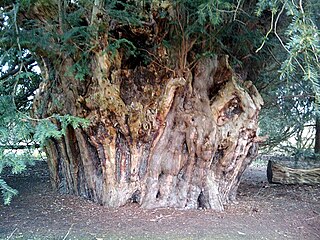
Taxus is a genus of coniferous trees or shrubs known as yews in the family Taxaceae. They are relatively slow-growing and can be very long-lived, and reach heights of 2.5–20 m (8.2–65.6 ft), with trunk girth averaging 5 m (16 ft). They have reddish bark, lanceolate, flat, dark-green leaves 10–40 mm long and 2–3 mm broad, arranged spirally on the stem, but with the leaf bases twisted to align the leaves in two flat rows either side of the stem. The oldest known fossil species are from the Early Cretaceous.

Taxus baccata is a species of evergreen tree in the family Taxaceae, native to western, central and southern Europe, northwest Africa, northern Iran, and southwest Asia. It is the tree originally known as yew, though with other related trees becoming known, it may now be known as common yew, English yew, or European yew. It is primarily grown as an ornamental. Most parts of the plant are poisonous, with toxins that can be absorbed through inhalation and through the skin; consumption of even a small amount of the foliage can result in death.

Ashbrittle is a village and civil parish in Somerset, England, situated nine miles west of Taunton and close to the River Tone and the route of the Grand Western Canal in the Somerset West and Taunton district. The village has a population of 225.

Lorton, a parish in the district of Allerdale of the English county of Cumbria, consists of two adjacent villages: Low Lorton and High Lorton. Both nestle at the northern end of the Vale of Lorton, surrounded by fells such as Grasmoor, Hopegill Head and Whiteside. They are about 4 miles (6.5 km) from Cockermouth, which gives access to the main A66 road. Other nearby places include Loweswater and Brigham.

Taxus cuspidata, the Japanese yew or spreading yew, is a member of the genus Taxus, native to Japan, Korea, northeast China and the extreme southeast of Russia.

The Fortingall Yew is an ancient European yew in the churchyard of the village of Fortingall in Perthshire, Scotland. It is known for being one of the oldest trees in Britain, with modern estimates of its age between 2,000 and 3,000 years.

Kingley Vale is a 204.4-hectare (505-acre) biological Site of Special Scientific Interest north of Chichester in West Sussex. It is also a Special Area of Conservation and a Nature Conservation Review site, Grade I. An area of 147.9 hectares is a national nature reserve.

The Ankerwycke Yew is an ancient yew tree close to the ruins of St Mary's Priory, the site of a Benedictine nunnery built in the 12th century, near Wraysbury in Berkshire, England. It is a male tree with a girth of 8 metres (26 ft) at 0.3 metres. The tree is at least 1,400 years old, and could be as old as 2,500 years.

The Llangernyw Yew is an ancient yew in the village of Llangernyw, Conwy, North Wales. The tree is fragmented and its core part has been lost, leaving several enormous offshoots. The girth of the tree at the ground level is 10.75 m (35.3 ft).

The Florence Court Yew is the surviving specimen of the two original Irish yew seedlings. As such, it is the oldest Irish yew alive and it is believed that almost all Irish yews worldwide descend from this specimen. It is located in Florence Court demesne in County Fermanagh, Northern Ireland and is cared for by the National Trust.

The Balderschwang Yew is an ancient European yew in Bavaria. It has two hollow trunks and stands alone on a mountain pasture. It is estimated to be between 600 and 1,000 years old, and is possibly the oldest tree in Germany.

Taxine alkaloids, which are often named under the collective title of taxines, are the toxic chemicals that can be isolated from the yew tree. The amount of taxine alkaloids depends on the species of yew, with Taxus baccata and Taxus cuspidata containing the most. The major taxine alkaloids are taxine A and taxine B although there are at least 10 different alkaloids. Until 1956, it was believed that all the taxine alkaloids were one single compound named taxine.

Bermiego Yew, also called in Asturias "Teixu l'Ilesia" is an ancient tree of the species Taxus baccata growing in the village of Bermiego in the Principality of Asturias, northern Spain on the western slope of the Sierra del Aramo. The tree can be found just outside the village within the precincts of the village chapel of Santa Maria de Bermiego.

Gümeli Porsuğu is a yew tree growing high in Zonguldak district of Black Sea Region, in Turkey. It is estimated to be 4,115 years old.

The Church of St John the Baptist is a Church of England parish church in Ashbrittle, Somerset. It was built in the 15th century, and is a Grade II* listed building.

The Craigends Yew (NS4199566134) is an ancient European layering yew growing next to the River Gryffe in what were the grounds of the Craigends Estate, Houston in Renfrewshire, Scotland. Estimates put its age at around 500 to 700 years old and it is one of the largest and oldest examples of a heritage layering yew in Scotland.

Millennium yews were planted in 2000 as part of a joint scheme between the Church of England and the Conservation Foundation, UK to celebrate the end of the 2nd millennium. The church promised a cutting, taken from some of the yews in its churchyards that are more than 2,000 years old, to any parish that wanted one. It expected to distribute a few hundred but by the end of 2000 had distributed 8,000. The project helped raise awareness of environmental issues within the church and provided a large collection of yew trees of known provenance.
















